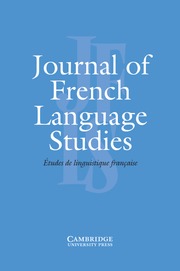Article contents
Introduction to Special Issue on French Variation in Digital Media
Published online by Cambridge University Press: 13 July 2022
Extract
Digital discourse, often referred to as computer-mediated communication, has revolutionized communication practices since the advent of the personal computer (Crystal, 2011), with ever-growing effects, as smart devices proliferate in every aspect of twenty-first-century human existence. Linguists in the francophone world first took note of these new digital interactional practices in the 1980s with the onset of conversation via Minitel (Levy, 1993), a French-born service that consisted of a computer terminal that connected via telephone lines to remote services like chatrooms, interactive games, and purchasing platforms, years before most Americans had ever heard of the world wide web (Mailland, 2017). Minitel terminals remained functional some 30 years later; the service was ultimately decommissioned in 2012 on account of outdated modems, an inability to support advancements in graphics and the earlier mass migration (in France and beyond) to the present-day internet (Mailland, 2017). But the introduction of virtual interactional spaces – in the francophone world and beyond – had marked the beginning of a new linguistic trend in which users found themselves regularly engaged in the production of written language infused with vernacular tendencies.
- Type
- Article
- Information
- Journal of French Language Studies , Volume 32 , Special Issue 2: Special Issue (French Variation in Digital Media) , July 2022 , pp. 115 - 119
- Copyright
- © The Author(s), 2022. Published by Cambridge University Press
References
REFERENCES
- 1
- Cited by



